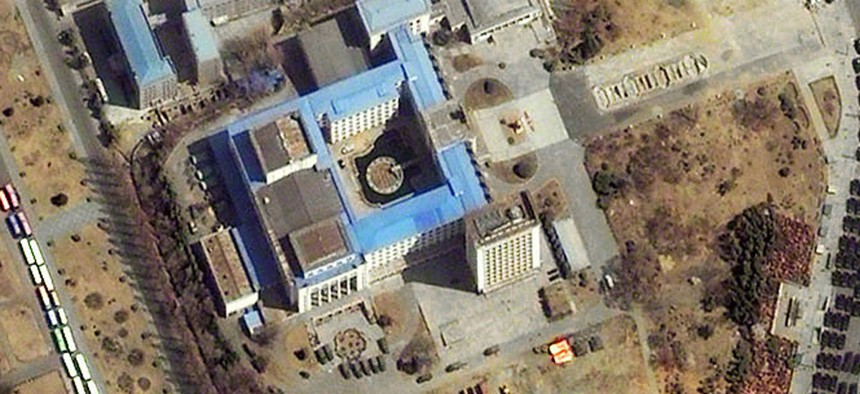
A parade marks the 100th anniversary of Kim Il Sung's birthday in Pyongyang, North Korea, April 15, 2012. AP Photo/DigitalGlobe, File
Satellite Firms Want Rules Eased for Intel-Quality Images
The satellite industry wants permission to sell images at twice the current resolution limit on the open market. By Joseph Marks
U.S. intelligence agencies soon could pay drastically reduced prices for the highest resolution satellite images that only they’re allowed to purchase from commercial providers. That limited market has irked private satellite companies, which say it leaves them little incentive to innovate. Their solution: let the firms sell the images to everyone else, too.
For more than a decade, commercial satellite providers have been barred from selling ultra high-resolution images, largely because of national security concerns that providers say are long outdated. That resolution limit of 50 centimeters -- one pixel in the satellite image must equal 50 centimeters or more on the earth’s surface -- was a distant dream when the rule was approved by the Commerce Department in 2000. At the time, satellite cameras could only manage an 80 centimeter resolution.
In recent years, however, commercial providers have launched a new generation of equipment, including a satellite that can collect images with a 25 centimeter resolution that the company DigitalGlobe plans to launch next year. U.S. satellite operators with advanced cameras must blur these images when they sell them on the open market. They can only sell the sharper images to a handful of U.S. government defense and intelligence agencies that are allowed to purchase them.
DigitalGlobe petitioned NOAA in May for permission to sell images at a 25 centimeter resolution. The images could be used by companies such as ESRI and Google to create more detailed digital maps, according to the company’s founder and chief technology officer Walter Scott. By broadening the market to such companies, the proposal also would drastically reduce the price intelligence agencies pay for the higher resolution images. While the intelligence community operates its own satellites, it also purchases numerous images from Esri, the government’s largest supplier of digital mapping systems, DigitalGlobe and other companies to supplement its own stock. About 35 percent of DigitalGlobe’s revenue last year came from a contract with the National Geospatial Intelligence Agency, Scott said.
(Related: Why the Military Needs Commercial Satellite Technology)
“If the cost of those images is spread over a larger customer base, then everyone wins,” he said. “The images cost less for everyone and we’re earning more money that we can plow into research and development.”
The new resolution limit would also benefit civilian government agencies. The U.S. Forest Service could use the images, for instance, to get a better picture of where different types of vegetation start and stop, and the Coast Guard and other agencies could gain a better understanding of the nation’s shoreline, said Lawrie Jordan, Esri’s director of imagery. The higher resolution images would also make it easier and cheaper for the U.S. military to distinguish between vegetation and camouflaged tarp, he said.
The new standard would also keep U.S. satellite companies competitive with other nations, including France and Russia, which have asked their governments for permission to sell sharper satellite images.
“I want America to maintain its lead in technology and particularly to maintain our lead in the high ground in space,” Jordan said. “Once upon a time [space] was a very thinly populated area. It was just us and a few other countries. Now everyone’s in space, but we’re still the leader, and I think we need to stay the leader.”
NOAA told DigitalGlobe it would need longer than the standard 120 day period to evaluate the request and to gather feedback from other agencies such as the State and Defense Departments, but hasn’t spoken further about the petition, Scott said. An NOAA spokesman said the agency could not discuss DigitalGlobe’s request in advance of its official response because of the danger of revealing any proprietary information in the request. The petition itself is sealed.
Scott and Jordan said they’re not aware of any significant domestic opposition to increased resolution limits from privacy groups or other quarters, largely because the proposed 25 centimeter resolution is still not clear enough to identify individuals. It’s also far less clear than aerial images, which can achieve resolutions of just a centimeter or two.
That claim seemed to be borne out by Defense One calls to the Electronic Frontier Foundation and other privacy groups, none of which had formed a specific position opposing the change, though they noted they had not looked at the issue closely.
“Even at a 20 centimeter resolution, you can’t recognize people from space,” Scott said. “They look like blobs really. So there’s not the level of concern people have, frankly, about the ubiquity of cellphone cameras.” Scott says he thinks any resistance to the new resolution standard is a holdover from an earlier era when cameras weren’t ubiquitous and when the U.S. controlled the majority of the world’s satellites. “In a world in which there are so many high resolution satellites that are not controlled by the U.S. government, this feels a lot like closing the barn door after the cows are out in the next country.”
The new resolution may make satellite images more competitive with aerial images in some cases where extremely high resolution isn’t necessary, Jordan said. Satellite images are typically much cheaper than aerial images and satellites can shift position rapidly, moving from North America to South America in just about 20 minutes, he said.
That will likely open up more opportunities for Esri in the private sector, he said, such as helping civil engineers assess the building stock across an entire city or helping insurance companies determine what caused a roof collapse based on recent images.
NEXT STORY: Drone Invades the New York Public Library





